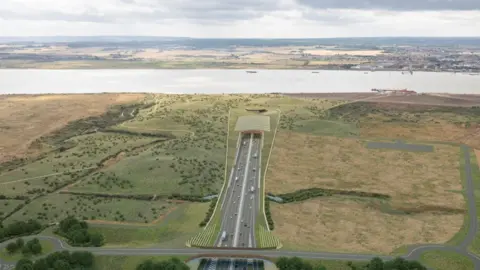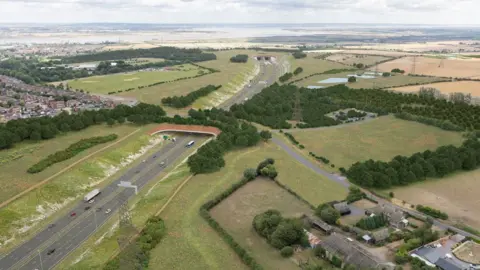Lower Thames Crossing: Trees along planned route are ancient woodland
 National Highways
National HighwaysCampaigners have renewed calls for the Lower Thames Crossing project to be scrapped after a small area along the proposed route was redesignated as ancient woodland.
The road linking Essex and Kent would be the longest car tunnel in the UK.
National Highways confirmed a small area of the Wilderness in Essex had been "redesignated" by Natural England.
The government agency said it would continue to "refine" its designs.
"Despite its new ancient woodland status, the Wilderness is still facing devastation," said Jack Taylor, lead campaigner at the Woodland Trust.
"We hold hope that government will do the right thing and not allow the Lower Thames Crossing scheme to go forward with so many irreplaceable habitats at risk."
'Vindicated'
The Wilderness covers more than three hectares off the B186 near South Ockendon and sits within the path of the proposed new carriageway.
Areas are granted ancient woodland status by Natural England - a non-departmental public body advising the government - if the land has been consistently wooded since at least 1600.
Thames Crossing Action Group chairwoman Laura Blake said the development meant "more ammunition" showing the crossing should not be built.
"We feel completely vindicated," said Ms Blake.
The plans are being assessed by the Planning Inspectorate, and if approved, work could start in 2026.
National Highways hopes it will open to traffic by 2030.
The planned road would be 14 miles long (23km) with 2.6 miles (4km) running underground and under the Thames.
 National Highways
National HighwaysMark Bottomley, development director for the Lower Thames Crossing, said National Highways was planting one million trees, a 100-hectare woodland at Hole Farm near Brentwood and creating two public parks to offset the project.
In a statement, he did not say whether any of the ancient woodland would be destroyed but said it would continue to "refine the design to reduce the impact further".
"We recognise the importance of the Wilderness and have changed our plans to significantly reduce the amount of land needed," he added.
 National Highways
National Highways
Follow East of England news on Facebook, Instagram and X. Got a story? Email [email protected] or WhatsApp 0800 169 1830
